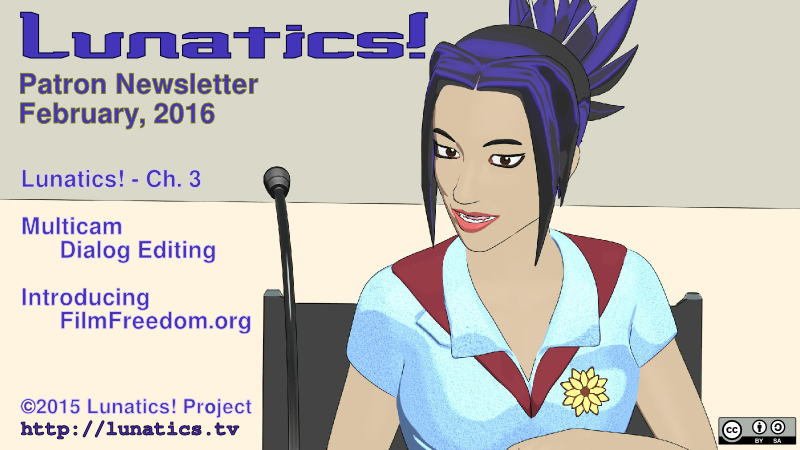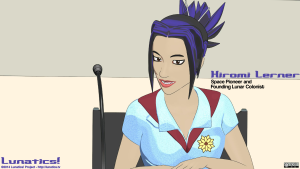Features this month include the 3rd chapter in Rosalyn Hunter’s serialization of “Lunatics!” Then we’ll take a look at how Terry Hancock is using a Blender-Multicam technique and OpenGL scene rendering to direct cameras for the Press Conference scene from “No Children in Space – Part 1”. And finally, following up from the ideas presented in the last newsletter, we’re introducing the beginnings of the Film Freedom project and its new website.
Lunatics!
Chapter 3 — Sightseeing
In Baikonur, there were carts and shops everywhere selling souvenirs, such as camels and groundhogs with the name of the town written on the front. Georgy thought that they looked silly, but Mama seemed to like them. She took out her phone and took a picture to send to Daddy.
She told Georgy that they first had to see all of the space sights. This was Mama’s first time at Baikonur. The first of the great world launch sites. They left the hotel with a woman named Josey who took them around town.
They got out of the car and walked around the park. It was full of flowers. The ground in some places was a bit bare. It reminded of her of their old home in Arizona. It was the same kind of short trees and bushes, except the bushes were different and there were no cacti. Also, it was very cold here. Georgy was wearing her winter coat despite the fact that it was sunny. The slight breeze chilled her cheeks, but she forgot that when she saw the statue.
It was really tall and red. On top there was a statue of a woman. The shadow cut across the sidewalk touching a streetlight. Georgy walked over to try to stand in the statue lady’s shadow, but Mama called and told her to get off of the grass.
She wanted to say that there wasn’t any grass there, only dirt, but she didn’t. Instead she walked out onto the sidewalk.
“This statue is called Science and Space,” Mama said, “I’ve seen postcards, but it’s so much more impressive to see for real.”
“Does the lady have a name?” Georgy asked.
Mama looked down at the tour book in her hand, “It’s called ‘Stella’ I think, but my Russian is not that great,” she said, “that makes sense. Stella means star.”
“I know that Mama, I’m not stupid,” Georgy said.
“Of course you’re not,” Mama smiled, “But you could be a little more polite.”
“Sorry Mama,” she said as she stared down at the tiles. They were hexagonal. She crept forward touching first one toe then another to the corner, then she made a game where she tried to jump over exactly three hexagons and land on the fourth one. She wasn’t quite making it.
“Look over here, Georgy. Let me take your picture.”
Georgy looked up. Standing on one foot and trying to stay in the hexagon.
“Put your foot down, Georgy,” Mama said, and she did, touching the ball of one foot down carefully to keep her from falling. The moment that she said “Okay” though, she lifted her foot and began to hop toward the statue again. The hexagons before the statue were stained red as if the rain had washed the color from the statue over them. She reached out and touched the surface. It was cold. She counted the stripes on the front. She looked up. It looked like the woman was holding a ball and snake over her head.
“Why does she have a snake?” Georgy asked.
“That’s not a snake,” Hiromi said shaking her head, “Come back here. You can see it better from further away.”
Georgy hopped across the tiles and stood beside her mother who placed a hand on her shoulder. “You see that is the Earth, and that thing spiraling around it and past her head is the trail of a rocket. She has made it possible for the rocket to leave the Earth. Science and technology has made it possible for us to reach beyond the Earth and venture into space. Do you understand?”
“It still looks like a snake to me,” Georgy said, “Can I run down the sidewalk?”
Mama gave a sigh. “Alright,” she said giving her shoulder a pat before pulling out her phone to take some more pictures.
At the next stop, they walked beside a white wall. She reached out and touched the pattern. It showed planets and space ships and it reminded her of the wall paper of her room back home. On the other side of the wall was another statue.
“This one is glory to the conquerors of space,” Mama said.
“Are we conquering space, Mama?” Georgy asked.
“Absolutely!” she said, “We are conquerors because we are going to stay.”
“Oh!” Georgy said, “So do we get to wear those pointed helmets?”
“What pointed helmets?”
“Like Cortéz wore.”
“You’re thinking of conquistadors,” she replied smiling, “Now look this way. I’m sending Daddy another picture.”
Georgy liked this statue. It was weird with a big blue ball in a cage and things pointing this way and that with a rocket on top and a thing that looked like a Soyuz but also like a duck with one wing. She wanted to get under it and climb, but mama wouldn’t let her.
The shadows this statue made were particularly fun to play on. She would jump from one to the other. “Look Mama, I’m on the Soyuz”, she said before jumping across to another shadow.
“In a couple days you really will be,” she said snapping another picture.
***
The town wasn’t really that big, but it had camels! Georgy saw one on the side of the road when they went to a street market. It was brown and fuzzy with two humps peeking through a blanket that was bright blue and embroidered with red flowers. She asked her mama and then reached out and touched it. It made a honking-mewing sound and she drew back, but the man standing beside it put a hand on its neck and nodded to her. When she pet it, it bent down and licked her fingers. The man was wearing a bright blue velvet costume with a hat strung with white lace. His robe reminded her a bit of Santa Claus or more likely Father Christmas. He smiled at her and she smiled back before running ahead toward the brightly colored stores.
They walked past the stalls. Some were decked out with fiber lights that glowed different colors and spelled out the names of the things that were for sale. Georgy thought they were pretty, but she still couldn’t read the Cyrillic characters.
There were other tourists at the market as well taking pictures of themselves and the carts. She passed one woman who pointed and took a picture calling out “space girl” as they walked by. Mother walked her down to the next row to get out of their way.
Mama stopped to admire some eggs that were shining all red and gold in the sunlight. They were covered with jewels. She picked one up and opened it to find that the inside was a beautifully decorated as the outside.
Georgy bent down to look at some toys. There were rattles and little dolls made of clay. Some horse shoes. One cart was completely covered with post cards. It also had nested dolls. Some were women wearing scarves. Some were groundhogs. One showed a cosmonaut with another inside of it. She tugged on her mother’s arm and pointed.
“Look Mama,” she said, “do you think that I’ll be the one in the middle?”
Hiromi came over to look. She opened the layers one by one and found a rocket in the middle. She looked down at Georgy, “Sorry, no girl inside, only a rocket.” Georgy shrugged and walked on past plates, and bells, and mugs, and paper books.
The market that they were in held many brightly colored things, but it just made Georgy sad. Before they left the car, her mother had said that they couldn’t buy anything because of the weight limitations. Georgy sulked. “What’s the point of going to a market if you can’t buy anything?” she whined as she watched her mother fingering a red scarf with sequins.
Mama looked down at her and relented. “Alright Georgy,” she said, “You can get one thing, but only one! Choose wisely because if it’s too big or heavy, we may need to leave behind your pencils or something else of yours to compensate.”
Georgy thought that Mama was probably not telling the truth about the pencils. They didn’t weigh much, and she had heard Sergei say that weight was not that much of a concern on this trip, but she understood Mama’s point. She was allowed to buy only one thing. The last personal thing that she would ever buy on Earth. She rushed forward looking through all the stalls to find it.
There was an angel made of crystal beads that sparkled in the sunlight, but there would be mostly artificial light on the moon. The only sunlight was filtered through the windows. It probably wouldn’t look the same. There were thin beautiful wind chimes that tinkled in the smallest breeze, but the moon had no wind. ‘Things on the moon won’t be the same as on the Earth’, she thought. ‘there won’t be birds, or bees, or oceans, or trees’…that’s when she saw it. In the back of a little stall, past the souvenir T-shirts. There was a row of little decorated boxes. Some were metal with bright jewels on the surface. One was glass, etched with swirls of white cloud in gold. But one box was made entirely of wood.
She walked forward and touched it. It was brown inlaid with lighter colored woods and painted with silver and gold like her storybook. There were lines carved into the surface. She traced one with her finger and it flowed around the lid of the box merging into other carved lines so that it never ended. A blue jewel sat right in the center of the lid, the color of the morning sky. She opened the box to find that it was lined with orange silk. She reached out to touch it, and found that you could lift it up to hide things underneath. The bottom was dark lined wood. How pretty it would look holding her leaves and stones. Her pencils might even fit inside so that Mama wouldn’t have to throw them away. She turned and held it out to her. “This. I want this,” she said.
Mama frowned for a second, looking the box over as if it might have knives sticking out of the edges. She opened the box and closed it again before handing it back to Georgy. “Are you sure? Do you want to look some more and come back?”
Georgy shook her head and Mama took the box back going to the woman at the head of the stall and paying with a twist of her wrist. That evening, when her mother was asleep in bed, Georgy pulled the shoe box out. She sat on the floor of the bathroom and carefully dumped all of her dirt into the bottom of the box. It smelled wonderful. Then she put the orange false bottom in and placed her acorn, rocks, and leaves onto it. The orange silk shining like trees in the fall, its shiny threads smooth under her fingertips. Then she tossed the shoe box into the trashcan. Mama probably wouldn’t have let her take that anyway. Georgy put the box into her bag and then crawled into bed pulling Tina close and smiling as she went back to sleep. She dreamed of the light shining through the leaves of the trees, but this time, the leaves were all orange.
***
The next morning was fun. After breakfast they met the base photographer and Georgy got to plant a tree. They had a small shovel just her size. She stood on it and dug a hole. She tossed the dirt behind her — not being careful to make it only one pile. Mama dug one too, but she had a very neat pile of dirt beside her hole. She enjoyed the digging, but then they told her it was time for planting. A man came over and deepened her hole which was apparently a bit the wrong size. Then she got on her knees and they shoveled the dirt in for her as she patted it down with her hands. Then she poured the silver bucket full of water onto the tree. She asked for more water because she knew from gardening that one bucket was not enough to start something as big as a tree, but they did not give her more. Apparently someone else was coming by later with a hose. Georgy wished that she could have used the hose. She was sure that if she sprayed the water just right, she could have made rainbows. She told Mama, but she only smiled. After it was over, her mother made her change clothes.
Next, they finally got to sign the door. Mama gave her a permanent marker and she signed down near the bottom. There was lots of space there. Other people liked to sign higher. Mama also signed, bending down so that her name was near Georgy’s.
They ate lunch and then got ready for the press conference. Mama spent a long time on her hair. They waited in a small room where Mama bent down and pulled at her jumpsuit.
“Now stand up straight and smile,” she said. “Say Hello when they introduce you and when it’s all over, you remember what to say?”
“I say, ‘Thank you all so much’.”
“That’s right, good. Now don’t worry, you can color if you want. Alright, deep breath. Let’s go.”
Chapter 4 coming in March!
Multicam Directing for Press Conference
For dialog-heavy scenes, like our Press Conference sequence, we have developed a method of animating, directing, and shooting that saves time by allowing the entire scene to be animated in one file, rather than setting up each shot separately. This is similar to multicam shooting in live or low-budget series television, in which multiple cameras are used to capture different views while the actors act out the scene, allowing the director to assemble the result by switching from camera to camera. Since we’re animating, there is stil a lot of detail to work out, but it’s much faster than storyboarding and animating each shot separately, and it allows for more spontaneity and intuition later in the editing process when the rhythm of the scene becomes more clear.
The basic technique is illustrated in this two-minute tutorial released this month:
Two-Minute Tutorial: Setting up Multicam in Blender
Of course, in reality, we’re using this for scenes like our “Press Conference” scene, where we have a group of people talking and need to cut frequently back and forth between people as they talk. This scene has a number of things going on — the dialog itself contains some exposition, some foreshadowing, some atmosphere, and some characterization. Meanwhile, the room and the sound environment is conveying mood. Silent shots include background material that will be significant in the next scene (although most of it isn’t present in our model yet).
A major factor with the scene is the glass divider between the reporters and the space travelers — because they are in quarantine right before the launch and don’t want to bring any infectious diseases with them. This largely controls the shooting of the scene, as we can see in the following blocking diagram:
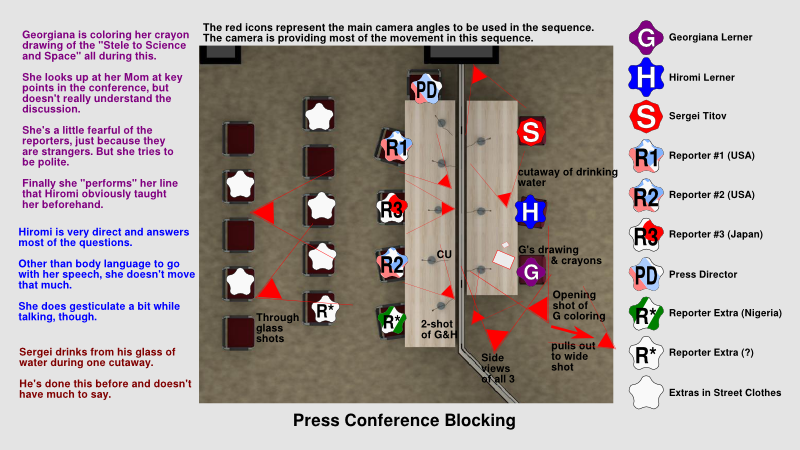
I created this diagram before setting up the camera shots — the red indicators showed where I thought we might put the cameras, as a guide for dressing the set and setting up the characters. In fact, I settled on four cameras for the multicam setup: two on each side of the glass windows, one each generally used for close-ups and the other for longer shots that included all or most of the animated characters.
I then rendered the entire scene using the OpenGL viewport rendering option for each of the four cameras. These are a lot faster than the final renders will be (about 2 seconds per frame, rather than 2 minutes! Although it still took hours for each to render this scene, which is about 3 minutes long). This gave me four complete pre-visualization renders of the scene from each camera, which I then combined in Kdenlive. Kdenlive has a split-screen feature that allows me to play through the scene while watching all four camera angles.
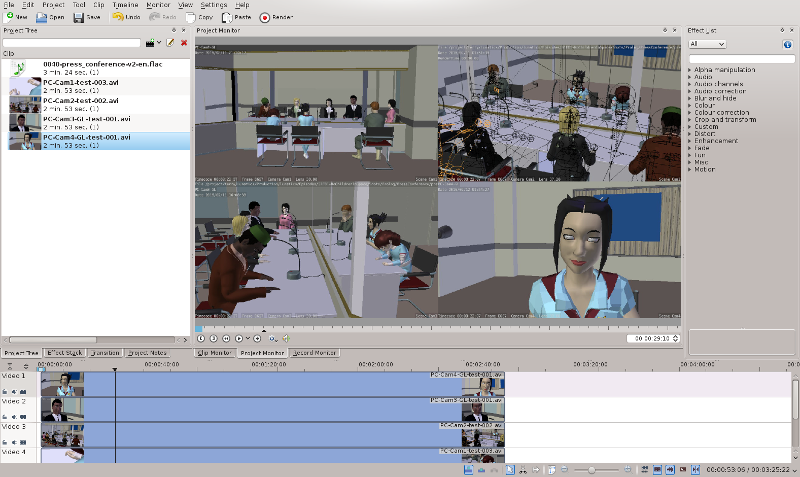
Once I had this, I could then edit the scene as if it were coming from live cameras, selecting which one had the best shot for each part. I cut together my first set of camera choices and came up with a rough draft of the angles I would want:
First draft of camera angles.
This looked pretty good, but a couple of bad things showed up. A few times, the camera simply pulled away from the subject at the wrong time, forcing me to make bad compromises on cutting choices. And secondly, there’s a few jarring cuts “across the line” (meaning a cut from a camera view on one side of an imaginary line between the two speakers in a dialog to a view on the opposite side). This causes some cognitive dissonance and disorientation, because the left/right orientation of the characters is reversed. This breaks one of the most basic rules in cinematography.
The reason is because I had moved the camera to the opposite side to get a better view of Sergei drinking from his water cup.
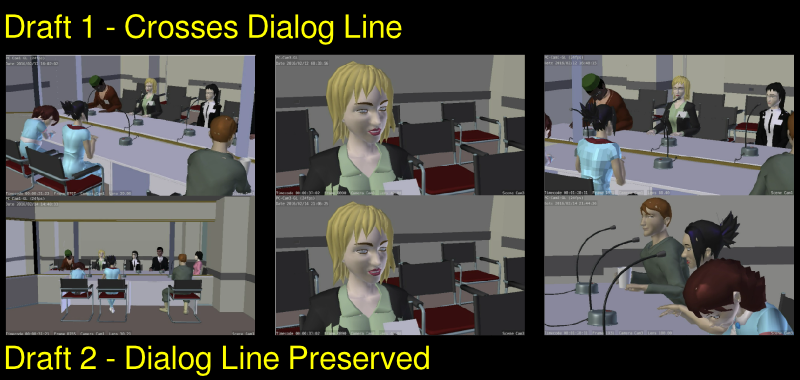
There are basically two ways to fix this problem. One is to insert a “cutaway” between the two shots (e.g. a close up of the water cup, as I had originally planned to do at this point) or one can reposition the cameras so they stay on the same side of the dialog line. In fact, I opted for the latter, moving the camera so that it could pull back further from the charactes, but not cross to the other side.
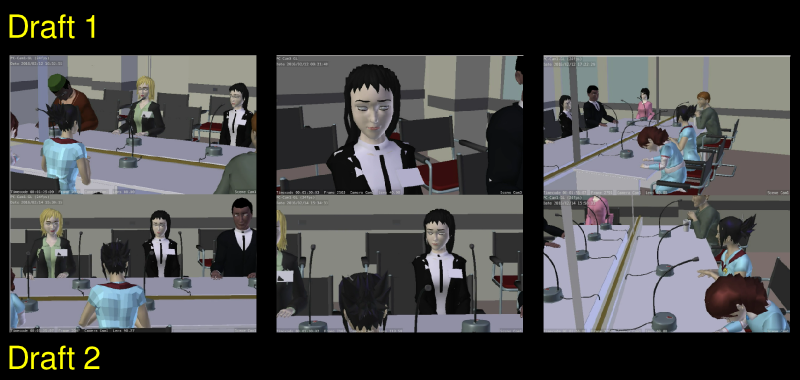
Other fixes have come up as well, such as the need to account for the shift in sound quality for Miki Matsumoto’s lines for Reporter #3 (the Japanese reporter). Unfortunately, due to the fact that we’ve recorded voices separately, the sound quality doesn’t sound exactly matched between different actors’ voices, because of differences in microphones and the acoustics of the rooms they were recorded in. These differences can be distracting if they are too great and if they are not explained by the action in the scene.
Miki’s voice sounds a bit like it’s “filtered” — at least more so than Karrie’s “Hiromi” lines before and after. Fortunately, there’s a creative fix for this, which is to explain the filtering by the way the scene is shot. Since our characters are talking to each other over a sound system in glass-separated rooms, it’ll sound quite logical if the characters sound filtered when shot through the glass, versus sounding clear when shot directly. Therefore we can fix this by adding a mild filtering effect to the voices at the right times. With Miki’s lines, which already sound filtered, we can simply make sure the character is only heard through the glass. So this edit replaces a direct shot with a through-the-glass shot. Of course, the glass is simply missing from these GL renders, because the GL render doesn’t support transparency, but in the final renders, you will be able to see reflections in the glass — sometimes giving us a glimpse of the reaction shot while a character is speaking.
So then I went back and tweaked all four camera movements. I adjusted the one camera that crossed the line so that it would sometimes go to the point of a long shot looking straight along the line, but never past that. And I adjusted the key frames so that some of the shots that were cut short wouldn’t have to be. And then I re-rendered, and tweaked the editing in Kdenlive to get a second draft that’s already much improved:
Second draft of camera angles.
No doubt I’ll make additional tweaks before settling on the final version of the scene.
Introducing FilmFreedom.org
Last month, I wrote up a description of the goals for the Film Freedom project, and this month, I’ve rolled out a very basic “stub” webpage to introduce the idea to free film producers and other interested parties. This is my “request for comment” on the project to see what sort of site and what sort of resources we ought to make available:
So we’ve decided to create a new site to host all of these infra-structure projects, to be called “Film Freedom”:
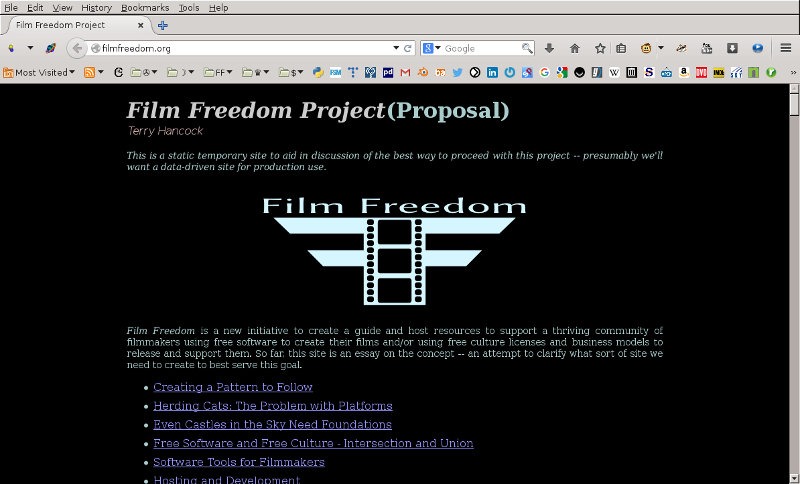
I’m sending out queries to free film producers — particularly those who are mentioned — to get corrections and updates on their projects; to find out what uses they can think of for the site; and what they might contribute themselves. In other words, this simple site is an invitation to collaborate.
Other News
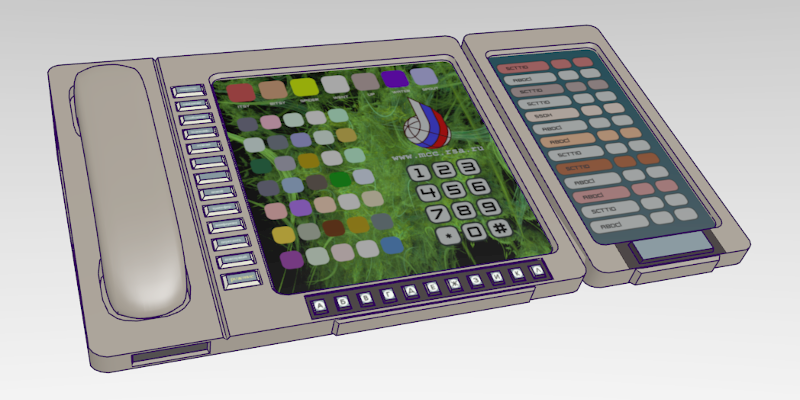
- Finishing Sets
- I’ve completed several textures for the “Aquarium Room” set used in the Press Conference scene and the Mission Control Room scene which appears as part of the launch sequence. There are still some geometry fixes needed in our updated Soyuz interior set, and a number of small fixes on the Launch Pad set. It’s amazing how long all these bits and pieces take to get in order.
- Infrastructure
- Having written up proposals for infrastructure for future use, I unfortunately have to accept that we don’t have time to work on it right now, and so I’m just continuing work on Part 1 of the pilot without them. This accounts for some of the slowness, but we have the ability to get it finished with what we’ve got. I’m not exactly sure when, but it’s coming, and the dialog animation technique described in this newsletter is a big time-saver.
- Newsletters
- Ha! It’s still February! I have caught up! Sort of.
Until Next Time!
